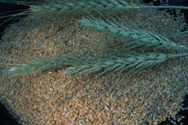
Photo © Steven Foster
Introduction
The wheat plant is a grass with long slender leaves and a head or spike containing 20 to 100 wheat berries.1 The outer covering of the berry is referred to as the bran and is filled with a substance called the endosperm and the heart of the berry, the germ.2 History and Cultural Significance
The wheat germ is the embryo from which a wheat plant grows,3 and although it constitutes only 2-3% of the entire berry, is the nutritionally richest part. It is one of the few plant parts in nature in which the entire vitamin B-complex is found. It also contains fiber, vitamin E and octacosanol.2,4 All wheat types trace their ancestry to einkorn, the oldest grain in existence.2 Wheat has been cultivated in Europe and Asia since the beginning of recorded history,5 perhaps for as long as 9,000 years.2 It is the second oldest cultivated cereal grain, with barley being the oldest.5 In ancient lore wheat represented prosperity, fertility, abundance and life. Fertility gods from Egypt, Greece and Rome all had wheat as one of their symbols.4 In the Roman Empire wheat was eaten only by the wealthy as it was much more expensive than barley and millet.5 Native Americans cultivated wheat and used it to make bread, cakes, porridge, tortillas and even drinks, while some tribes used it to barter for other goods.6 For Christians, bread is a symbol of the body of Christ and plays a central role in the ordinance of communion. For Jews, unleavened bread is eaten during Passover to signify their escape from Egyptian bondage more than 3,000 years ago.4 Wheat is the staple food for many cultures worldwide. It is the main ingredient in many whole grain foods and is the most globally widespread carbohydrate crop.2 The wheat germ can be added to cereals, fruits and breads.4 It has a nutty flavor and is very oily, which causes it to spoil quickly.7 Therefore, the best way to incorporate wheat germ into the diet is to eat whole wheat grain or whole grain products. It is important to distinguish that refined wheat products do not contain the germ, only the endosperm, and are up to 70% less nutritional than whole grain wheat products.4 According to Ayurvedic medicine, wheat can be used to treat variable stress and mental problems and is good for improving musculature.2 Other healthy effects include nurturing the heart and calming or focusing the mind.2 Fiber contained in wheat is used as bulking agent to avoid constipation. Wheat germ oil, an extract of the germ, is used in cosmetics as an emollient and moisturizer.8 Modern Research
While wheat germ and its components are being studied in animals for cholesterol-lowering effects9 and the promotion of endurance,10 the only current human study on wheat germ extract is exploring its supportive potential in people undergoing cancer treatments.11 Future Outlook
Global production of wheat is 553 million tons, with 105 million tons traded annually. Asia leads in world production with 60%, China constituting two-thirds of that amount. From 1974 to 1994, wheat was the only crop that kept up with the growth in demand. International wheat output exceeds the demand by a considerable margin, which keeps the prices down. There are no wheat shortages in the foreseeable future.7 References
1 “Wheat.“ Encyclopedia Britannica Online. 2005. Available at: http://search.eb.com.content.lib.utexas.edu:2048/eb/article-9076739. Accessed November 15, 2005. 2 Wood R. The New Whole Foods Encyclopedia. New York: Penguin Books; 1999. 3 .]Whitney E, Rolfes S. Understanding Nutrition. 9th ed. Belmont, CA: Wadsworth/Thomson Learning; 2002. 4 Onstad D. Whole Foods Companion: a Guide for Adventurous Cooks, Curious Shoppers & Lovers of Natural Foods. White River Junction, VT: Chelsea Green Publishing Company; 1996. 5 Davidson A. The Oxford Companion to Food. New York: Oxford University Press; 1999. 6 Moerman D. Native American Ethnobotany. Portland, OR: Timber Press; 1998. 7 Research & Impact: Areas of Research: Wheat. Consultative Group on International Agricultural Research. 2004-2005. Available at: http://www.cgiar.org/impact/research/wheat.html. Accessed November 15, 2005. 8 New and Improved Wheat Uses Audit. National Association of Wheat Growers. September 2002. Available at: http://www.wheatworld.org/pdf/NAWG%20New%20Improved%20Uses%20Report%20Final.pdf. Accessed November 15, 2005. 9 Kato S, Hasegawa S, Nagasawa J, et al. Octacosanol affects lipid metabolism in rats fed on a high-fat diet. Br J Nutr. 1995;73:433-441. 10 Kim H, Park S, Han D, et al. Octacosanol supplementation increases running endurance time and improves biochemical parameters after exhaustion in trained rats. J Med Food. Winter 2003; 6(4):345-351. 11 Farkas E. Fermented wheat germ extract in the supportive therapy of colorectal cancer (Hungary). Orv Hetil. September 11, 2005;146(37):1925-1931.
|